Third Single Alteration: Dominant Sharp 5
and
Fourth Single Alteration: Dominant Flat 5
The Dominant 9, Sharp 5 and the Dominant 9, Flat 5 are both included on this page because the melodic vocabulary for each is the same;
Augmented (Whole-tone) scales and triads.
As is the case with Dominant 7 chords with a flat 5, the Dominant 9 chord with a flat 5 is many times nomenclated as a Dominant 9, Sharp 11 (sharp 11 is the octave of the flat 5, spelled enharmonically.
First, the scalar concept. The Augmented Scale based on the root of the chord works well because it includes both the sharp 5 and the flat 5, thus stating the altered notes of the chord. The 2nd (9th) is included which states the extension (the 9th), and the root, 3rd, and 7th are stated as well - all the bases are covered.

All the information on the Altered Dominant 7 page applies, including the Augmented Box.
Another scalar concept I use is the Mixolydian Mode - except I flat the 5th (this scale will also work with the Altered Dominant 7). The scale would be this:

Here's a phrase using this scale. Consider the sharp 2 a passing tone.

Secondly, concerning the use of Augmented Triads: when looking at a C9 (#11) it is easy to see the Bb augmented triad:
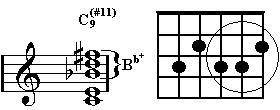
The triad for C9+ is a little more difficult to visualize. The chord looks like this:
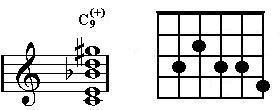
The chord is spelled low to high: C E Bb D G#. C, E, and G# spell a C augmented triad. To visualize the triad from the chord shape, take the Bb and the D in the above shape and raise them a whole step. They then become a C and an E thereby rendering the top 3 notes of the chord as C E G# = C augmented.
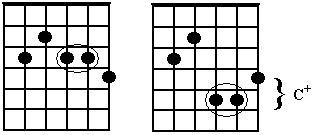
So for C9 (#11) the triad is Bb+. For C9+ the triad is C+. This demonstrates the whole tone movement of the augmented tonality. Any augmented triad, scale, &/or box can be used as long as it occurs in the whole tone sequence derived from your starting point, be it Bb, C or whatever.
Again, all the information on the Altered Dominant 7 page applies, even the very same examples. Nevertheless, I'll give another one here based on the Augmented Box pattern. It starts on the 7th of the chord and I've ascended
the two bar phrase in whole steps twice.
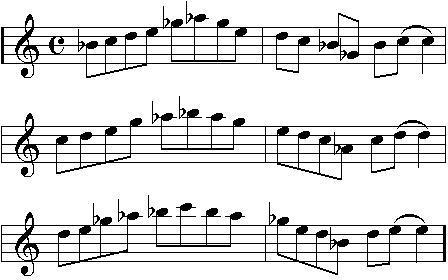
Lastly, another concept is suggested by the C9+ chord shape.
The top 3 notes of the chord (Bb, D, Ab) spell a close position
Bb7 Chord with the 5th omitted.
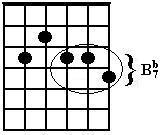
So using a Bb7 arpeggio as a basis for soloing over a C9+ will work.
Here's an example:

II - V - I Examples
These examples could just as easily been used on the Altered Dominant 7ths page. Because the V chord (G9+) has an altered 5 the whole-tone scale and augmented boxes apply.
Over the D-7 is a D Minor Scale (the C# is a passing tone).
Over the G9+ is a Whole-Tone Scale (the F# is a passing tone).
Over the Cmaj7 is a C Major Scale (it could also be an E Minor Scale).

Example 2:
Over the D-7 is D Minor Pentatonic. Over the G9+ is a Whole-Tone Scale.
Over the Cmaj7 is a C Major Scale.



